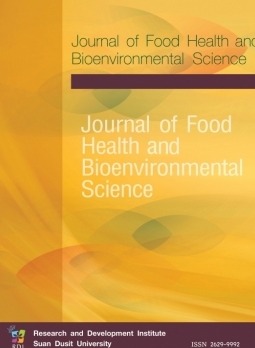Effect of Chilling and Freezing Storage of Cookie Dough on Dry Roasted Pork Cookie Quality
Keywords:
Cookie quality, Cookie dough, Chilling and freezing, Storage conditionAbstract
Low temperature is an easy technique which preserves and retains product quality. The objectives of this research were to develop the Trang local roasted pork pieces into cookies and to study the effect of chilling and freezing of cookie dough on cookie quality. The methodology of research was conducted by studying 3 different levels (25%, 50% and 75%) of dry roasted pork suitable to be cookie and study the cookie properties: microbiological and physical quality. The results of this research indicated that addition of dry roasted pork into cookie dough at 50% level received the highest sensory score for all aspects. The 50% dry roast pork cookie dough was studied regarding chilling and freezing storage condition, and determined color, spread ratio and textural quality. The color parameters were determined through lightness (L*), redness (a*) and yellowness (b*) values of both cookie dough models stored under chilling and freezing and the results showed that these values increased with increasing retention time. In terms of cookie color from chilling and freezing cookie dough, it was found that L* and a* decreased but b* was unchanged. The spread ratio for both cookies from chilling and freezing dough decreased, the spread ratio of freezing dough was lower than chilling dough. When cookie’s textural quality was investigated, hardness value from both chilling and freezing cookie dough increased after week 2 and increase rate continued until week 6. In addition, the chewiness value increased for both cookies from chilling and freezing dough. The fracturability of cookies from chilling and freezing dough slightly increased after 6-week storage. Crispiness value of both cookies from chilling and freezing dough were stable as early as 2 weeks and continually increased until last storage time at week 6.
References
Agu, H.O., Ayo, J.A., Paul, A.M., & Folorunsho, F. (2007). Quality characteristics of biscuits made from wheat and African breadfruit (Treculia africana). Niger. Food J., 25(2),19-27.
Ávalos, A., Goytiño, P., Conforti, P.A., & Lupano, C.E. (2016). Sensory and texture properties of “chipá”: Influence of ingredients and storage conditions of batter. Cogent Food & Agriculture, 2(1), 1275394.
Chevallier, S., Colonna, P., Buleon, A., & Della Valle, G. (2000). Physicochemical behaviors of sugars, lipids, and gluten in short dough and biscuit. Journal of Agricultural and Food Chemistry, 48(4), 1322-1326.
Dogan, S.I. (2006). Effect of oven types on the characteristics of biscuits made from refrigerated and frozen doughs. Food Technol. Biotechnol., 44, 117–122.
Gupta, M., Bawa, A.S., & Abu-Ghannam, N. (2011). Effect of barley flour and freeze–thaw cycles on textural nutritional and functional properties of cookies. Food and Bioproducts Processing, 89(4), 520-527.
Hamed, A., Ragaee, S., Marcone, M., & Abdel, Aal, E.S.M. (2015). Quality of bread and cookie baked from frozen dough and batter containing β-glucan-rich barley flour fraction. Journal of Food Quality, 38(5), 316-327.
Hoseney, R.C., & Rogers, D.E., (1994). Mechanism of sugar functionality in cookies: The science of cookie and cracker production. American Association of Cereal Chemists: St. Paul, MN.
Hwang, H. S., Singh, M., & Lee, S. (2016). Properties of cookies made with natural wax–vegetable oil organogels. Journal of food science, 81(5), C1045-C1054.
Kumar, P., Chatli, M.K., Mehta, N., Malav, O.P., Verma, A.K., & Kumar, D. (2016). Quality attributes and storage stability of chicken meat biscuits incorporated with wheat and oat bran. Journal of Food Quality, 39(6), 649-657.
Kun Mae Manee. (2018). Salted dry shrimp (Wang Klai Kangwon recipe). Retrieved January 5, 2020, from https://cooking.kapook.com/view199585.html
Leray, G., Oliete, B., Mezaize, S., Chevallier, S., & de Lamballerie, M. (2010). Effects of freezing and frozen storage conditions on the rheological properties of different formulations of non-yeasted wheat and gluten-free bread dough. Journal of Food Engineering, 100(1), 70-76.
Manaf, Y.N., Marikkar, J.M.N., Mustafa, S., Van Bockstaele, F. & Nusantoro, B.P. (2019). Effect of three plant-based shortenings and lard on cookie dough properties and cookies quality. International Food Research Journal. 26(6), 1795-1802.
Maturin, L.J., & Peeler, J.T. (2001). Chapter 3, aerobic plate count. Retrieved October 19, 2020, from https://www.fda.gov/food/laboratory-methods-food/bam-chapter-3-aerobic-plate-count
O’Brien C.M., Chapman D., Neville D.P., Keogh M.K., & Arendt E.K. (2003). Effect of varying the microencapsulation process on the functionality of hydrogenated vegetable fat in short dough biscuits. Food Res Int., 36, 215–221.
Olaoye, O.A., Onilude, A.A., & Oladoye, C.O. (2007). Bread fruit flour in biscuit making: Effect on product quality. African Journal of Food Science, 71, 41-16.
Olewnik, M.C., & Kulp, K. (1984). The effect of mixing time and ingredient variation on farinograms of cookie doughs. Cereal Chemistry, 61, 532-537.
Patrignani, M., Conforti, P.A., & Lupano, C.E. (2014). The role of lipid oxidation on biscuit texture during storage. International Journal of Food Science and Technology, 49, 1925–1931.
Purlis, E. (2011). Bread baking: technological considerations based on process modelling and simulation. J. Food Eng., 103, 92–102.
Rasanen, J., Blanshard, J.M.V., Siitari-Kauppi, M., & Autio, K. (1997). Water distribution in frozen lean wheat flour doughs. Cereal Chem., 74, 806–813.
Rawendra, R.D., & Dwi, G.N. (2020). Enrichment of soft ice cream with different fibrous fruit puree: Physicochemical, textural characteristics and sensory properties. In IOP Conference Series: Earth and Environmental Science ( p. 012178). Indonesia: IOP Publishing.
Rogers, D. (2004). Functions of fats and oils in bakery products. Journal of the American Oil Chemists' Society, 15(9) 572–574.
Sikorski, D. (2004). Application of diacylglycerol oil in baked goods, nutritional beverages/bars, sauces, and gravies. Diacylglycerol Oil, 223-252.
Thailand Public Health. (2013). Notification of the Ministry of Public Health No.364 B.E.2556: Royal Thai Government Gazette 130. special issue 148.
Zamora, R., & Hidalgo, F.J. (2005). Coordinate contribution of lipid oxidation and Maillard reaction to the nonenzymatic food browning. Critical Reviews in Food Science and Nutrition, 45, 49–59.
Downloads
Published
How to Cite
Issue
Section
License

This work is licensed under a Creative Commons Attribution-NonCommercial-NoDerivatives 4.0 International License.








